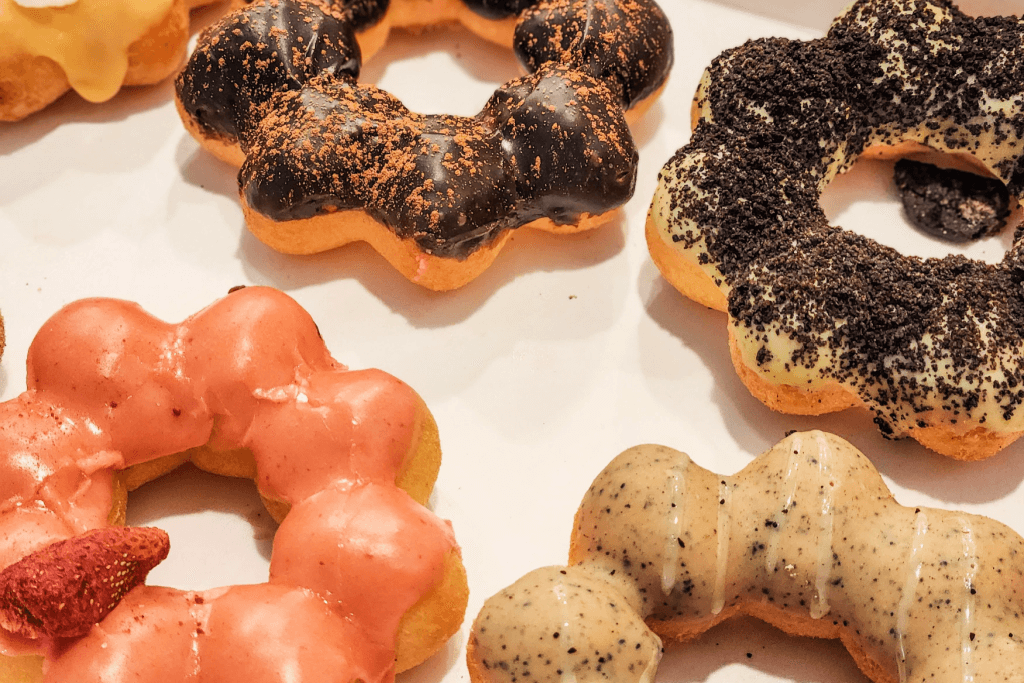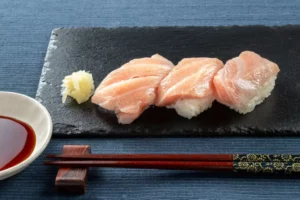Although donuts didn’t originate from Japan, several varieties of the beloved golden brown ring-shaped sweets are unique to the country. One of the most popular stores that sell Japanese donuts is Mister Donut; they can be found in almost any lively shopping district alongside cafes and restaurants.
Perhaps the donut most often associated with their brand in Japan is Mister Donut’s signature Pon de Ring donut. It has a distinct shape resembling small round donuts joined in a ring. These are consistently available at all branches, affordable, and a beloved sweet snack for everyone.
Table of Contents
TogglePon de Ring donuts vs Mochi donuts
If you’re not familiar with Pon de Ring donuts, there’s a similar type known as mochi donuts. By comparing the ingredients in their recipes, we can understand their distinctions. One of the main differences between these two types of Japanese donuts is the dry ingredients used.
Mister Donut Japan’s official recipe uses tapioca or wheat flour for Pon de Ring donuts. Mochi donuts, however, are made with glutinous rice flour, the same as actual mochi, which explains their name. As for their texture, Pon de Ring donuts are described as having a soft, airy, bouncy texture. Meanwhile, mochi donuts are described as having a more dense and chewy texture.
Ingredients for Pon de Ring donuts
Next, let’s take a more detailed look at the ingredients needed to make a Pon de Ring donut. To recreate these famous Japanese donuts, we have the usual dry ingredients used in many baking recipes, like baking powder, sugar, and salt, and for the yeast dough, it is recommended to use instant yeast to make the baking process more straightforward and less time-consuming.
As we mentioned earlier, the secret to Pon de Ring donuts lies in the flour used for them. The recipe for Mister Donut uses tapioca flour. Still, since they typically use machines that automatically shape the donuts and are meant to create huge batches. As a result, home chefs will have to make necessary adjustments depending on what cooking appliances they have.
Are you interested in discovering more about traditional Japan? Check out Sakuraco! Sakuraco sends traditional Japanese sweets, snacks, and tableware from across Japan to your door so that you can enjoy the experience!
How can I make Pon de Ring donuts?
Suppose you want to make Pon de Ring donuts as close as possible to the original recipe while not causing you any headaches when shaping them into those iconic rings. In that case, you can use a 60/40 mixture of tapioca flour and plain or all-purpose flour. While tapioca flour is gluten-free, if you might be concerned about gluten, you can easily substitute the all-purpose flour with a gluten-free version of your choice.
However, suppose you want to step it up a notch. In that case, another alternative recipe uses all-purpose flour, tapioca starch (not flour), potato starch, and a slightly unusual wet ingredient that we’ll get into in a little bit.
For the tapioca flour recipe, the only wet ingredients you will need are eggs and melted unsalted butter. For the alternative recipe that uses tapioca starch, you will also need firm tofu, which will be gradually added once you’ve combined all the other ingredients.
Making Japanese donuts!
Finally, we are at the part where we get to make Pon de Ring donuts (and proceed to try them if you’ve never had one before). Once you mix all the ingredients and have a nice consistency dough, it’s time to shape the donuts. The standard look for a Pon de Ring donut is made up of 8 small balls that form a ring. Place the balls on top of cut parchment paper sheets that are just a little bit bigger than the size of your donut. The size all depends on your preference, as long as you can make the balls as even as possible.
Since these are famously deep-fried Japanese donuts, the next course of action is frying the donuts. You can use vegetable oil for this, and after you’ve heated it to around 160 to 170 C, you can slowly place the donuts onto the hot oil while they’re still on top of the parchment paper. Wait around 2 minutes on each side when frying, or at least until both sides are golden brown.
Once both sides are done, you can grab the donuts with tongs and place them on a paper towel to cool and get rid of the excess oil at the same time. Last, you get to add your favorite flavor to your donuts! While you can always go for the plain ones, making strawberry-glazed or matcha-glazed ones is also fun for that extra Japanese flavor. Now you know the secrets behind one of the most famous Japanese donuts! Even if you cannot visit a Mister Donut in Japan to get the real thing, we hope you’ll try these for a sweet, delectable snack at home.











2 Responses
Hello, I am interested in making these pon de ring donut, May I know a more detailed recipe for this? Thank you so much
Hi, you can find the recipe on a lot of cooking channels or websites. All of them should be delicious! 😄